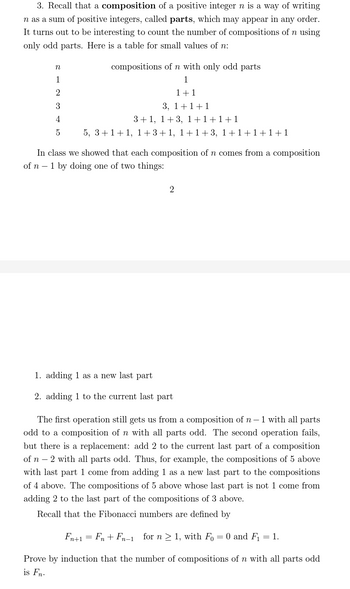
Advanced Engineering Mathematics
10th Edition
ISBN: 9780470458365
Author: Erwin Kreyszig
Publisher: Wiley, John & Sons, Incorporated
expand_more
expand_more
format_list_bulleted
Question

Transcribed Image Text:3. Recall that a composition of a positive integer n is a way of writing
n as a sum of positive integers, called parts, which may appear in any order.
It turns out to be interesting to count the number of compositions of n using
only odd parts. Here is a table for small values of n:
n
1
2
3
4
5
compositions of n with only odd parts
1
1+1
3, 1+1+1
3+1, 1+3, 1+1+1+1
5, 3+1+1, 1+3+1, 1+1+3, 1+1+1+1+1
In class we showed that each composition of n comes from a composition
of n - 1 by doing one of two things:
1. adding 1 as a new last part
2. adding 1 to the current last part
2
The first operation still gets us from a composition of n-1 with all parts
odd to a composition of n with all parts odd. The second operation fails,
but there is a replacement: add 2 to the current last part of a composition
of n 2 with all parts odd. Thus, for example, the compositions of 5 above
with last part 1 come from adding 1 as a new last part to the compositions
of 4 above. The compositions of 5 above whose last part is not 1 come from
adding 2 to the last part of the compositions of 3 above.
Recall that the Fibonacci numbers are defined by
Fn+1
=
Fn+Fn-1 for n ≥ 1, with Fo= 0 and F₁ = 1.
Prove by induction that the number of compositions of n with all parts odd
is Fn.
Expert Solution
This question has been solved!
Explore an expertly crafted, step-by-step solution for a thorough understanding of key concepts.
Step by stepSolved in 2 steps with 2 images

Knowledge Booster
Similar questions
- 1. List all partitions of the integer: (a) 4, (b) 6.arrow_forwardHow many three – digit numbers can be formed fromthe digits 1, 2, 5, 6, and 9 if each digit can be usedonly once? 6.1 From the answer above, in how many area. even? b. Odd? c. Numbers greater than 600? d. How many three digit numbers can be formedif repetition is allowed?arrow_forward14. How many 4-digit numbers can be formed using digits from {1,2,3,4.5) if repeated digits are allowed? O 525 O none of these O 400 O 210arrow_forward
- A basket contains 2 pink, 3 yellow, 8 red, and 1 black jelly beans. You grab a handful of 4 jelly beans. (a) How many groups of 4 jelly beans include exactly 1 of each color? (b) How many groups of 4 jelly beans include at most 1 yellow?arrow_forwardSelect the number line that shows that two opposite numbers have a sum of 0. A. B. C. D. -8 -7 -6 -5 -4 -3 -2 -1 0 1 2 3 4 5 6 7 8 6 4 -8 -7 -6 -5 -4 -3 -2 -1 0 1 2 3 4 5 6 7 8 2 -8 -7 -6 -5 -4 -3 -2 -1 0 1 2 3 4 5 6 7 8 3 -8 -7 -6 -5 -4 -3 -2 -1 0 1 2 3 4 5 6 7 8 SUBMITarrow_forward2. I found some bingo cards in our classroom. A bingo card seems to have 5 rows and 5 columns. The center cell is blank, but the remaining cells each contain a number. No two cells contain the same number. In the first column, integers from 1 to 15 are used. In the 2nd column, integers from 16 to 30 are used, and so on. Thus, in the 5th column, integers from 61 to 75 are used. How many different bingo cards are there? Explain.arrow_forward
arrow_back_ios
arrow_forward_ios
Recommended textbooks for you
 Advanced Engineering MathematicsAdvanced MathISBN:9780470458365Author:Erwin KreyszigPublisher:Wiley, John & Sons, Incorporated
Advanced Engineering MathematicsAdvanced MathISBN:9780470458365Author:Erwin KreyszigPublisher:Wiley, John & Sons, Incorporated Numerical Methods for EngineersAdvanced MathISBN:9780073397924Author:Steven C. Chapra Dr., Raymond P. CanalePublisher:McGraw-Hill Education
Numerical Methods for EngineersAdvanced MathISBN:9780073397924Author:Steven C. Chapra Dr., Raymond P. CanalePublisher:McGraw-Hill Education Introductory Mathematics for Engineering Applicat...Advanced MathISBN:9781118141809Author:Nathan KlingbeilPublisher:WILEY
Introductory Mathematics for Engineering Applicat...Advanced MathISBN:9781118141809Author:Nathan KlingbeilPublisher:WILEY Mathematics For Machine TechnologyAdvanced MathISBN:9781337798310Author:Peterson, John.Publisher:Cengage Learning,
Mathematics For Machine TechnologyAdvanced MathISBN:9781337798310Author:Peterson, John.Publisher:Cengage Learning,


Advanced Engineering Mathematics
Advanced Math
ISBN:9780470458365
Author:Erwin Kreyszig
Publisher:Wiley, John & Sons, Incorporated

Numerical Methods for Engineers
Advanced Math
ISBN:9780073397924
Author:Steven C. Chapra Dr., Raymond P. Canale
Publisher:McGraw-Hill Education

Introductory Mathematics for Engineering Applicat...
Advanced Math
ISBN:9781118141809
Author:Nathan Klingbeil
Publisher:WILEY

Mathematics For Machine Technology
Advanced Math
ISBN:9781337798310
Author:Peterson, John.
Publisher:Cengage Learning,

